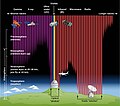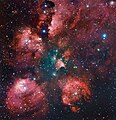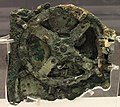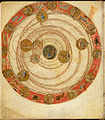Portal:Astronomy
|
The Astronomy Portal
Introduction Astronomy is a natural science that studies celestial objects and the phenomena that occur in the cosmos. It uses mathematics, physics, and chemistry in order to explain their origin and their overall evolution. Objects of interest include planets, moons, stars, nebulae, galaxies, meteoroids, asteroids, and comets. Relevant phenomena include supernova explosions, gamma ray bursts, quasars, blazars, pulsars, and cosmic microwave background radiation. More generally, astronomy studies everything that originates beyond Earth's atmosphere. Cosmology is a branch of astronomy that studies the universe as a whole. Astronomy is one of the oldest natural sciences. The early civilizations in recorded history made methodical observations of the night sky. These include the Egyptians, Babylonians, Greeks, Indians, Chinese, Maya, and many ancient indigenous peoples of the Americas. In the past, astronomy included disciplines as diverse as astrometry, celestial navigation, observational astronomy, and the making of calendars. Professional astronomy is split into observational and theoretical branches. Observational astronomy is focused on acquiring data from observations of astronomical objects. This data is then analyzed using basic principles of physics. Theoretical astronomy is oriented toward the development of computer or analytical models to describe astronomical objects and phenomena. These two fields complement each other. Theoretical astronomy seeks to explain observational results and observations are used to confirm theoretical results. Astronomy is one of the few sciences in which amateurs play an active role. This is especially true for the discovery and observation of transient events. Amateur astronomers have helped with many important discoveries, such as finding new comets. (Full article...) General images -The following are images from various astronomy-related articles on Wikipedia.
This is a Featured article, which represents some of the best content on English Wikipedia.
Callisto (/kəˈlɪstoʊ/ kə-LIST-oh), or Jupiter IV, is the second-largest moon of Jupiter, after Ganymede. In the Solar System it is the third-largest moon after Ganymede and Saturn's largest moon Titan, and nearly as large as the smallest planet Mercury. Callisto is, with a diameter of 4,821 km, roughly a third larger than Earth's Moon and orbits Jupiter on average at a distance of 1,883,000 km, which is about six times further out than the Moon orbiting Earth. It is the outermost of the four large Galilean moons of Jupiter, which were discovered in 1610 with one of the first telescopes, being visible from Earth with common binoculars. The surface of Callisto is the oldest and most heavily cratered in the Solar System. Its surface is completely covered with impact craters. It does not show any signatures of subsurface processes such as plate tectonics or volcanism, with no signs that geological activity in general has ever occurred, and is thought to have evolved predominantly under the influence of impacts. Prominent surface features include multi-ring structures, variously shaped impact craters, and chains of craters (catenae) and associated scarps, ridges and deposits. At a small scale, the surface is varied and made up of small, sparkly frost deposits at the tips of high spots, surrounded by a low-lying, smooth blanket of dark material. This is thought to result from the sublimation-driven degradation of small landforms, which is supported by the general deficit of small impact craters and the presence of numerous small knobs, considered to be their remnants. The absolute ages of the landforms are not known. Callisto is composed of approximately equal amounts of rock and ice, with a density of about 1.83 g/cm3, the lowest density and surface gravity of Jupiter's major moons. Compounds detected spectroscopically on the surface include water ice, carbon dioxide, silicates and organic compounds. Investigation by the Galileo spacecraft revealed that Callisto may have a small silicate core and possibly a subsurface ocean of liquid water at depths greater than 100 km. (Full article...) Did you know -
More Did you know (auto generated)
WikiProjectsSelected image - Messier 82, also known as NGC 3034, Cigar Galaxy, and M82, is the prototype starburst galaxy about 12 million light-years away in the constellation Ursa Major. The starburst galaxy is five times more luminous than the whole Milky Way, and one hundred times more luminous than our galaxy's center. This mosaic image, taken by the Hubble Space Telescope, is the sharpest wide-angle view ever obtained of Messier 82. Astronomy News
November anniversaries
Space-related PortalsAstronomical eventsAll times UT unless otherwise specified. Portal:Astronomy/Events/November 2024 TopicsSubcategoriesSelect [►] to view subcategories
Things you can do
WikibooksThese books may be in various stages of development. See also the related Science and Mathematics bookshelves.
WikijuniorAssociated WikimediaThe following Wikimedia Foundation sister projects provide more on this subject:
Discover Wikipedia using portals Shortcuts to this page: Astronomy portal • P:ASTRO Purge server cache |






























































